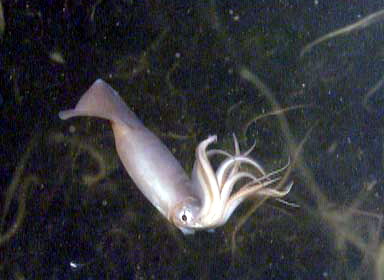|
| Query: British fishes | Result: 196th of 201 | |
Humboldt Squid (Dosidicus gigas) - Wiki
| Subject: | Humboldt Squid (Dosidicus gigas) - Wiki
| |

| Resolution: 384x280
File Size: 27249 Bytes
Date: 2007:09:20 23:34:34
Upload Date: 2007:09:20 23:39:45
|
Humboldt Squid
From Wikipedia, the free encyclopedia
[Photo] Humboldt Squid photographed by ROV Tiburon. Humboldt squid (Dosidicus gigas) swarm around Tiburon, possibly attracted to its lights. Several of the large (about 1- 2 meter, or 3-6 foot) animals clouded the water with greenish-gold ink. Source: http://oceanexplorer.noaa.gov/explorations/06davidson/logs/summary/media/squid_600.html Date 2006. Author Image courtesy of NOAA/MBARI 2006. License: public domain
The Humboldt Squid (Dosidicus gigas), also known as Jumbo Squid, Jumbo Flying Squid, Giant Squid, Diablo Rojo, Pota or Calamari, is a large, aggressive predatory squid found in the waters of the Humboldt Current in the Eastern Pacific Ocean. They are most commonly found at depths of 200-700 metres (600 to 2300 feet), from Tierra del Fuego to California. Recent findings suggest the range of this species is spreading north into the waters of Oregon, Washington, British Columbia and Alaska.
Behavior and general characteristics
Humboldt Squid are carnivores that move in schools of up to 1200 individuals. They swim at speeds of up to 15 miles per hour (24 km/h, 13 knots) propelled by water ejected through a hyponome (siphon) and by two diamond shaped fins. Their tentacles bear suckers lined with sharp teeth with which they grasp prey and drag it towards a large, sharp beak.
Humboldt Squid are thought to have a lifespan of only about one year (however some researchers believe they may survive up to four years). They may grow to 2 m (7 ft) and weigh 45 kg (100 pounds), growing at an astounding rate. They can rapidly change their skin colour from deep purplish red to white using chromatophores (specialized skin cells) in what some researchers believe is a complex communication system. Experts have also stated that the animals hunt for their prey, small fish and krill, in a cooperative fashion, which would be the first observation of such behaviour in invertebrates. There have been reports of these squid attacking divers and fishermen in the Sea of Cortez.
Recent research suggests that the squids are only aggressive while feeding. At other times, they are quite passive.
Body characteristics
Generally, the tube (or body) constitutes about 40% of the animal's mass, the fin (or wing) about 12%, the tentacles about 14%, the outer skin about 3%, the head (including eyes and beak) about 5%, with the balance made up of the inner organs. In circumstances where these animals are not being grossly overfished, they exhibit very curious and intelligent behavior.
Recent footage of pods of these animals demonstrates a tendency to meet unfamiliar objects aggressively. Having risen to depths of 400-600 feet below the surface to feed (up from their typical 2,000 foot diving depth, beyond the range of human diving), they have attacked deep-sea cameras and rendered them inoperable. Reports of recreational scuba divers being attacked by Humboldt Squid have been confirmed. One particular diver, Scott Cassell, who has spent much of his career videotaping this species has developed body armor to protect against attacks. Each of the squid's suckers is ringed with sharp teeth, and the beak itself can tear flesh, although it's believed they lack the jaw strength to crack heavy bone. Nevertheless, they eat their prey by grabbing it with their tentacles and biting it repeatedly with their beak. Working together, several squid are able to devour large prey very quickly.
Fishing
Commercially, this species has been caught to serve the European community market (mainly Spain, Italy and France), Russia, China, Japan, South East Asian and increasingly North and South American markets.
The squid are fished at night, when it is easier to lure them with lights used by fishermen that make the plankton shine, which makes the squids rise to the surface to feed themselves. Since the 1990s, the most important areas for landings of Humboldt Squid are northern Peru and Mexico.
There are numerous accounts of the squid attacking fishermen and divers in the area and attacks on humans are regularly seen, but only when they are being fished. Their colouring and aggressive reputation has earned them the nickname diablos rojos (red devils) from fishermen off the coast of Mexico as they flash red and white when struggling with the fishermen.
http://en.wikipedia.org/wiki/Humboldt_Squid
| The text in this page is based on the copyrighted Wikipedia article shown in above URL. It is used under the GNU Free Documentation License. You may redistribute it, verbatim or modified, providing that you comply with the terms of the GFDL. |
|
Comments |
|---|
| | Guest |
|
Scientific Name: Dosidicus gigas (D'Orbigny, 1835)
Common Names: Humboldt Squid, Jumbo Flying Squid, Jumbo Squid
Synonyms:
Ommastrephes gigas D'Orbigny, 1835
Dosidicus eschrichtii Steenstrup, 1857
Ommastrephes giganteus D'Orbigny, 1839-1842 in Férussac and D'Orbigny, 1834-1848
Dosidicus steenstrupii Pfeffer, 1884
Sepia nigra Bosc, 1802
Sepia tunicata Molina, 1782 |
^o^
Animal Pictures Archive for smart phones
^o^
|
|
|

